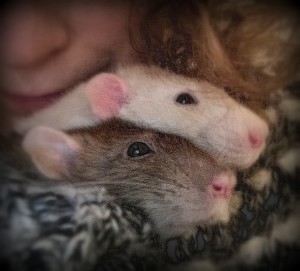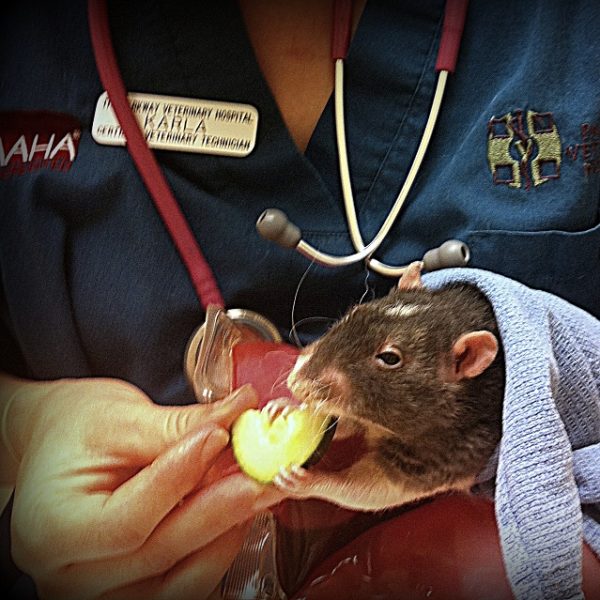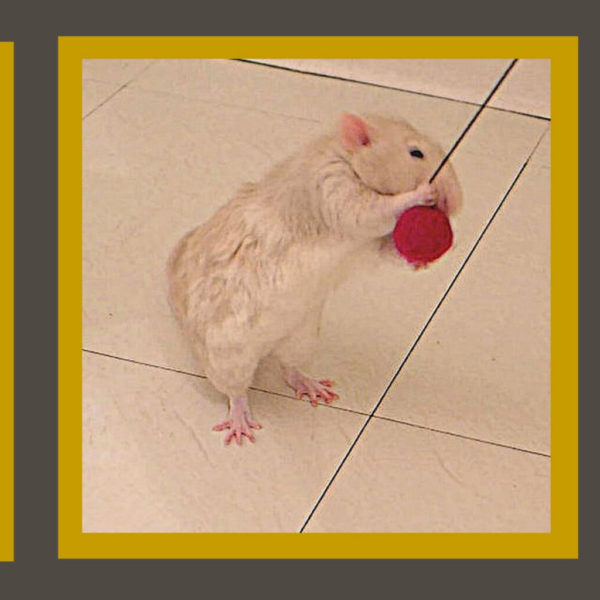
Introducing pet rats to one another is an art. The process of introductions can often take over a month to accomplish. Despite the challenges, it’s one of the most rewarding experiences you can have with your pet rats. What could be more satisfying than successfully introducing new rats to one another?…..and then having them end up as life-long buddies?
Here are instructions starting with how and why to quarantine your new rat. Next are easy-to-follow guidelines designed to develop trust and teamwork, resulting in lasting rat friendships.
QUARANTINE
Quarantine any new rats for 3 weeks. This is important in case your new rat is diseased, has external or internal parasites or any other compromising health condition. Be sure to familiarize yourself with signs of pet rat disease or illness if you haven’t already done so. The quarantine period helps keep your current rats healthy and safe. It also allows you and your new rat to become acquainted with one another.
While in the quarantine phase it’s important to:
- Keep your new rat in a part of your house/apartment that doesn’t share “airspace” with your current rat(s). It’s absolutely necessary they be in a different room. In addition, the room in which your new rat is housed should be as far away from your current rat(s) as possible. Ideally this means on a different floor. Some people even choose to have their new rats quarantined in a separate house or apartment altogether.
- Change your clothes after being with your new rat. This helps prevent the spread of any disease to your current rats.
- Add an extra layer of caution by showering after visiting with your new rat, before visiting with your current rat(s)
- Have your new rat examined by a veterinarian who’s both knowledgeable and experienced with pet rats within the first week of bringing him or her home. This way a doctor/patient relationship can be established and your veterinarian may catch something you haven’t yet noticed. When problems are detected early, they’re so much easier to treat. Taking your new rat to the vet will help ensure your current rats will be introduced to a healthy new rat friend. If you don’t already have a trusted vet for your pet rats, read Choosing a Veterinarian.

The quarantine period helps keep your current rats healthy and safe and it allows you and your new rat to become acquainted.
PET RAT INTRODUCTIONS
Use these tips and best practices for all phases:
- Conduct at least two sessions a day, ideally one in the morning and one in the evening.
- Keep introduction sessions brief, lasting for no more than 10-15 minutes. Even a 5 minute session is helpful. Your goal is to not even give your rats a chance to get upset, anxious or aggressive. If you see they’re about to become negative or combative, calmly stop the intro session immediately. The other benefit of having short sessions is you want your rats to end each session wanting more. If the session is brief, it gives your rats an opportunity to look forward to the next time they get to see one another.
- Use yummy treats reserved for introduction sessions only. Especially in the beginning stages, your rats may be too distracted to eat. As you progress through the pet rat introduction phases, however, the special treats will give them a positive association for each session.
- If you do observe aggression (or avoidance) at any time you can:
- 1) Back up a step
- 2) Repeat the phase you’re in
- 3) Return to the first step of Phase One until you see your rats are more comfortable with getting acquainted
- While following the guidelines below, always use your common sense to choose what best fits your rats. Your goal is to help your rats be as comfortable and curious about one another as possible.
- During pet rat introductions, talk softly and let your rats know everything is okay. They’ll definitely pick up on your emotions so it’s important you’re calm and relaxed throughout each session.
- Be especially attentive to your current rat. They need to know they’re still very much loved, even in the presence of a new rat.
- If you’re introducing a new rat to several current rats, first try the introductions with all of your current rats. If this doesn’t seem feasible—-or if you find the new rat gets overwhelmed OR if your current rats gang up—introduce your current rats one at a time, then in pairs and then, lastly, as a group to your new rat.
PHASE ONE
- Place your new rat and current rat(s) in separate small cages. Cat carriers work perfectly for this. If you don’t have two cat carriers, small cages will do.
- Position the carriers about six inches apart and allow your rats to sniff the air and to see one another through the bars of the cat carrier.
- Give them each a treat. As mentioned above, they may be too distracted to show an interest in food during this phase. However, it’s still worth associating each session with food they love whether or not they eat it.
- If any of your rats start puffing up, sidling toward the door of the carrier, making “hissing” sounds or ANY sign of aggression, stop the intro session for that day. The next day repeat the intro, but place the carriers farther apart than before.
- When all goes well, keep repeating Phase One while gradually placing the carriers as close together as possible without your rats being able to touch one another.
- After you’ve observed your rats being curious and interested in each another while in their separate carriers, switch out the carriers so they’re each in a different carrier than they were before.
- Repeat for several days, allowing them to sniff and see one another while switching their carriers for each session.
If they seem comfortable after 4-7 days (i.e. they seem curious about one another instead of aggressive or anxious), it’s time to move to the next phase. If they act as if they don’t care there’s another rat, that’s fine. Just be sure they’re not cowering in a corner due to fear. If they do show fear, continue with Phase One for as long as it takes for them to become untroubled when being near one another.

PHASE TWO
Place dabs of food on a dinner plate. Choose foods that have the consistency of a thick liquid or pudding. (Organic is best!) The idea is you want to create a communal dining experience.
Foods that work well for pet rat introductions:
- Baby food – organic chicken is a great choice
- Soy or cashew yogurt
- Soup
- Tomato sauce
- Hummus – spread thinly to prevent choking
- Peanut butter – also spread thinly to prevent choking
Decide where you want to conduct your rats’ one-on-one meetings. A bed, dining room table or the floor in a rat-proofed bathroom are all great spots for pet rat introductions. Just make sure it’s an unfamiliar area for your current rats since it needs to be a neutral territory.
I don’t recommend bathtubs for pet rat introductions. The reason is your rats will have nowhere to go if they want to get away to protect themselves.
Spread out a blanket on the surface you’ll be using and place a t-shirt or two on top of the blanket. Sometimes both rats will burrow into a t-shirt and get to know one another very comfortably while inside the small space.
Put the dinner plate dabbed with food in the middle of the introduction area. Have on hand a bath towel or a large t-shirt as well as a roll of paper towels. These can be used to quickly and safely separate your rats from one another in case of aggression.
Bring your rats to the introduction area in separate carriers or have one rat in a carrier and the other on your shoulder. Put the new rat in the introduction area first. This helps your current rat feel more secure since there won’t be the surprise of having a new rat suddenly appear in front of him or her.

Here’s a video of Phase Two introductions with two of my own rats. Notice one rat flips the other onto her back. The rat being flipped doesn’t mind it, which means the introduction is going successfully. Often one rat will need to be in charge. As long as the non-dominant rat accepts being flipped and pinned on his or her back, there’s no problem.

If your rats are food motivated and really like eating the foods on the dinner plate you’ve provided, each day choose a smaller size dish. By the time you’re down to the size of a soy sauce dish, they’ll be side by side enjoying their shared meal.
Repeat this phase for several days until your rats are at ease with one another.

PHASE THREE
For this phase, I like to use a separate cage from the normal one in which my rats are housed. The Rat Manor is perfect for this. Place your new rat and current rat in the cage together. The idea behind this is that both rats are in a totally new territory. They become united while exploring this new frontier together. It’s a shared adventure and a bonding experience.

As always, the first session should be only 10-15 minutes. If they seem to be getting along fine, increase each twice daily session by about 5 minutes until you’re up to 30 minutes—at which time you’re ready for Phase Four.
PHASE FOUR
Before placing your rats together in their regular cage, make sure to clean and disinfect the cage. Once your rats’ regular cage is cleaned, disinfected and completely redecorated, place your rats together inside the cage.
Be prepared with a towel and a roll of paper towels in case you need to separate them. At this point, if they seem to be getting along well, you can leave them together. As an extra precaution, however, plan on being in the same room with them for several hours. If you see them behaving peacefully (i.e. cuddling, eating food side by side, building nests together) you’ll know it’s a success.
If you observe any sort of animosity while they’re inside their regular cage, this is your cue to go back at least one step or phase. Otherwise, CONGRATULATIONS on creating new rat friendships!
Updated 5/3/23








Hi,
I recently adopted 1 rescue who is 1 1/2 yrs. I was advised that I should get him a friend so that he wouldn’t be lonely. So I did. It has been about 1 1/2 months since the new rat, 5 months old,is with us. We did all the introducing steps, cages close to each other, swapping toys etc. Finally after a few weeks I put them together. My older rat got really puffy and they started fighting. He also closes his eyes and tries to get under the younger one. The younger one is mostly terrified and stands frozen on his back legs, will squeek and run away. We have kept introducing them slowly. Sometimes in a carrier where they seem ok for long amounts of time but don’t interact. And sometimes on the bed. We offer treats..the big ones loves to eat but the little one has no interest. We can’t really tell who is the alpha as they are both seem scared and dominant. We love them both and want them to be friends.
Any advice?
Thanks
Hi Tanya,
When you first put your 2 rats together, were they in an area that was unfamiliar to both of them? This is key. You want to create a shared experience for them where they’re both learning their surroundings for the first time. This unfamiliarity with their surroundings forces them to explore the new territory together. This includes on your bed or inside a carrier or cage or even in a bathroom. (Make sure your bathroom is safe for your rats.)
If you don’t have a lot of different new areas for them to experience, then add new items to your bed or inside the carriers, cage or bathroom. These could include boxes, fleece blankets piled up so they can go inside the pile, objects they’ve never seen before such as balls and other types of toys. You can even place things like a kleenex box on your bed.
You mentioned your little one hasn’t been wanting to eat when being introduced to your larger rat. Can you make sure your little one is hungry when doing the introductions? And make sure to offer treats that your little one truly loves. The smaller and smaller plate of food exercise mentioned in my article above has always worked for me.
While your 2 rats are together, make sure to give your older rat extra love and reassurance. Give him pats and talk to him encouragingly. Let him know he’s number one. You can even ignore your younger rat during the introductions. Just make sure you give your older rat tons of support during the process. It’s scary for them to think another rat is going to come in and disrupt everything including their relationship with you.
Remember this is a process. It can be slow going and sometimes you may have to go back a step. If you do go back a step, allow them to be together at whatever stage they’re comfortable with one another for a few days. Then gradually go to the next level.
Remember, too, if you’re tense while doing the introductions, they’ll feel your energy. Talking gently with them during the process really does help. They hear your calm, soothing voice and know it can’t be all that bad.
Spending time with each of your rats individually (away from the other rat) is a good idea, too. It will really pay off by helping them each know you’re there to support them.
I’m hoping that your little one will get to the point where he’ll submit to your older rat. Have you read Play, Tiff or Clash: Understanding Pet Rat Relationships? It might give you some additional insight.
Also, make each introductory period brief. 10 minutes or less is fine, done a couple of times a day. When they start tolerating one another, gradually increase by 5 minutes or so each day. The main thing is to set them up for success. Don’t give them a chance to not get along.
Finally, there may be a chance you’ll need to get your older rat neutered. But I would wait at least a month of trying the above ideas before doing so.
Make sure to take them to a veterinarian who’s knowledgeable about and experienced with pet rats. There could be an underlying health issue causing the inability to tolerate the other rat.
I hope these ideas are helpful for you. Let me know if you have any further questions and/or need any clarification on what I’ve written.
I’m confident that, in time, you will be able to get your boys to live harmoniously together. While you’re in the middle of the process, it feels like it’s taking forever and that they’ll never get along. However, with multiple brief meetings each day in new environments and with you there to support them, they will eventually learn to coexist.
Best Wishes to You & Your Rats,
Jasmine | About Pet Rats
P.S. I used to have a rat named Tanya. :)
Hello! this is very useful thank you. I am following the method you described to introduce two younger rats (almost 3 months old) to my older rat (1 year and 3 months). They were doing fine on the table, so I moved them to an empty cage. They have been meeting twice a day for about 1 hour each time for two days but one of the younger rats always stays in a corner. The other two rats interact with him and they even sleep together, but he doesn’t leave the corner. Do you have any suggestions? thank you so much.
Hi Stephanie,
I would try having the shyest rat with just one other rat inside the cage. When you do this, place things inside the cage that neither rat has seen before. These could be boxes, a branch, toys, etc. What you want to do is create a shared experience for these 2 rats. Another way to create a shared experience is to use liquid foods smeared around smaller and smaller sized plates (as mentioned in the post above). You can do this for these 2 rats while they’re inside the cage.
Once those 2 rats become more acquainted and are interacting with one another, then try your shyest rat with the other rat, doing the same thing. (i.e. create shared experiences with novel objects in the cage and smaller and use smaller plates with liquid food dabbed around the perimeter.) Literally anything they can experience together that’s new is helpful. This could also include playing with your hand inside the cage. (Most rats like it when you pretend your hand is a rat and you gently wrestle with them.)
Once you have the shy rat used to being with each of the other 2 rats, you can try them all together again. Also, keep in mind, as long as they’re not fighting (and there’s no puffed up fur or any signs of impending aggression,) it’s okay for the shyest rat to be on their own at first. They may just take longer to warm up to the other rats.
Let me know if you need further suggestions. I think you’re definitely on the right track! Also, feel free to update me on their progress.
Best Wishes to You & Your Rats,
Jasmine | About Pet Rats
Thank you for this! I’m wondering the best way to reintroduce after a fight, when the rats are still scared of humans. I have 4, 6 mo male rescues who are under socialized and still a bit afraid of us. There was a fight with one injured, and while we gave him his own space and are neutering all of them, I worry that we should reintroduce sooner than it may take for them all to be comfortable with humans so he’s not alone or they don’t gang up on him. With these phases it seems a requirement that they be comfortable with humans first or we wont be able to tell if they are afraid of us or each other. Any advice in this unique situation to ensure the initially hurt buddy isn’t hurt again but also isn’t too lonely and scared?
Hi Rachel,
When introducing pet rats, I don’t think it really matters If they’re socialized with humans yet. I believe my method of introducing rats to one another works just as well for rats not used to humans.
Not being used to humans doesn’t change the process at all of introducing rats. I do think it would be a little more difficult if some of the rats were used to humans and some weren’t. That said, I don’t think it really matters how they’re relating to humans when you’re introducing or re-introducing rats. You don’t have to be super well bonded with your rats to help them achieve the goal of living together harmoniously.
If you’re worried you won’t be able to tell if they’re afraid of you or of the other rats, then stay in the background and keep your contact with them minimal. Think of yourself as their “coach” or even as their “therapist”. You are there simply to guide and monitor them.
Keep in mind it can take as long as 6-8 weeks post-neuter for hormonal aggression to subside. You’ll be able to judge for yourself how well and how quickly they’re progressing. There’s a chance you may see improvement as soon as a couple of weeks.
Getting them all neutered at the same time becomes a bonding experience for them. They’re all going through the same experience together at the same time.
While they’re recovering from surgery and being kept separate, it’s a great time to work on developing their trust in humans. They’ll each get more one-on-one time with you post-surgery. Some of the ideas in Bonding with Your Pet Rats will be helpful. You might also like some of the tips in From Shy to Social Butterfly.
While you’re keeping them separated, make sure they’re still able to see and smell one another. The only exception would be if any of the rats show signs of aggression just by being near to another rat. In that case you’d want to keep them farther away, especially while they’re healing from surgery.
When you do the re-introductions, you could start as if you were introducing 4 new rats from 4 different homes using the methods outlined in this post. I’m guessing from what you wrote that you’ll be getting all 4 neutered at the same time.
If this is incorrect, and you’re only getting 1 neutered at a time, start with the rat who was the most aggressive toward the injured rat. I once adopted 3 brothers and neutered them one at a time. I ended up only needing to neuter 2 of the 3. (You can read more about this on my Spaying & Neutering page. It’s in the “Anecdotal Note” right above the heading “The Neuter Procedure”.)
I hope you find what I’ve written helpful. Feel free to ask for clarification, give me any clarification and/or let me know how they’re doing!
Best Wishes to You & Your Rats,
Jasmine | About Pet Rats
Hi, thank you for the helpful guide!
I’m writing because I’ve been introducing a 3-5mo old to a pair of 1.5yr old boys, none neutered. After most introductions at this point, the “baby” comes away with some injury or another. I’m considering stopping the introductions completely but would love some advice before giving up.
I think I botched phase 2, putting them first in smaller carriers together following the “cage method”. Now, trying to do the phase 2 on this guide, even in a big area, the older rats who used to not care much about the baby’s existence, will “hunt” him. Is there any hope to reset this or should I expect to keep them separate here on out?
Hi Jeff,
My opinion is it’s always possible to make it work. It just takes a LOT of time and patience.
I’m unclear, did you do Phase One as described in my post? That first phase is critical.
During Phase 2, did you try the shared food smeared around the edges of a dinner plate? I’ve always found that works better than anything!
It may be helpful for you to introduce the baby to just one of your adult boys at a time. That way it’s one-on-one rather than two against one. After the one-on-one’s are going well, then you can gradually try all 3 together.
Remember to keep all intro sessions brief. Stop before any problems can occur. Stopping early also gives them the chance to anticipate the next time—it helps them look forward to it.
I hope some of these ideas are helpful. Let me know if you need any clarification or if you have additional questions.
I’m rooting for your boys to be able to live together in harmony.
Jasmine | About Pet Rats
Hello! Firstly, your blog is amazing, Thankyou so much!
I’m about to conduct my first introduction. A month ago I brought home Phantom (10mo, male). He’s a rescue, he’s red eyed, and was bullied by his previous cage mates. He spent several months in a foster home being socialized, but he hasn’t lived with other rats since. He bites; mostly sniff-nips, sometimes too hard and breaks skin. When I first got him, he drew blood every time he encountered my skin. He’d snuggle in my sweater, but as soon as he found the edge of my t shirt I got chomped on.
He’s come along way, now I only get gentle sniff-nips, and the real bites only happen if I’m not careful while I’m in working in his cage, if my hands smell like food, or if he is startled. Otherwise, he’s cuddling, being pet, asks me to lift him places etc. Progress is slow, but steady. I have read your article on biting and the comments there, and I’m definitely going to use the trick with the feather in his cage!
His potential cage mates are Freya and juniper (6mo, female, spayed) they are both sweet, gentle, and confident. They’ve met a few times already through the bars, and I’ve been swapping their linens/toys between the cages. The girls are interested, but don’t care all that much. They’ll sniff his scent, cuddle in his hammock/blankets, but they hardly react anymore if they smell him.
Phantom is far more enthusiastic. He never brings bedding into his pod unless it’s from the girls’ cage, and he only uses hammocks while they smell like them (he prefers his hut or pod). He has calmed down a fair bit, but he’s stillquite excited.
He seems lonely and bored; I do my best, he gets scavenging toys and several hours with me everyday, but I can’t replace other rats. I want to introduce him as soon as I can, but I don’t want to push to fast and further traumatized him, or risk my girls getting hurt. He’s a big boy.
Any and all advice is helpful, I was also hoping for your input on a particular behaviour of his that seems conflicted. It first happened the day after he met the girls through cage bars (we backed up a little, as he spent the next few hours looking for them). The next day, he grabbed my hand and dragged it into the cage, biting it quite hard. He’s done it since, I was less surprised and let him take it. He kinda sat on it in the back of the cage, licking my blood and nibbling my skin. I had to change his linens after, since I’d bled all over them.
Puncture wounds aside, he’s a very sweet boy. I really want to get him happily settled with the girls; I think they’re the perfect situation for him (he did bond through cage bars with a couple young females at his foster home), the only obstacle is my lack of experience.
Thankyou!
Hi Luce,
I am SO SORRY I missed seeing your comment earlier….plus I’ve gotten behind on responding anyways….but somehow I really missed seeing your comment completely.
How’s it going now with Phantom, Freya and Juniper?
From what you wrote you sound like you have the perfect attitude for working with your rats and for creating the most loving and stimulating environment for them that you possibly can. I’m really impressed. One example of this is how you’ve been switching their linens/toys to the girls’ and to Phantoms cages. I also love how much you’re observing how they respond to this.
I really think Phantom is biting you because he has red eyes. You probably already read about how this makes them more likely to bite since their eyesight isn’t very good in my article on Pet Rat Biting.
It sounds like you’re on the right track with your introductions. I’d love to hear where you currently are in your process. I think one of the main things you’ll be needing to do is to watch out for puffed up fur when you’re doing the introductions outside of the cages in a neutral environment.
I’m also wondering if neutering could help Phantom bite less. He might have some aggression due to hormones (in addition to his poor eyesight). That’s great that your females are spayed.
Feel free to write with an update and I’ll be glad to help in any way I can. Again I apologize for taking so long in which to respond. I sure hope things are going well with their introductions. It really does sound like you have the perfect mindset for observing your rats and making adjustments as needed while going through the introduction process.
Best Wishes to You & Your Rats,
Jasmine | About Pet Rats